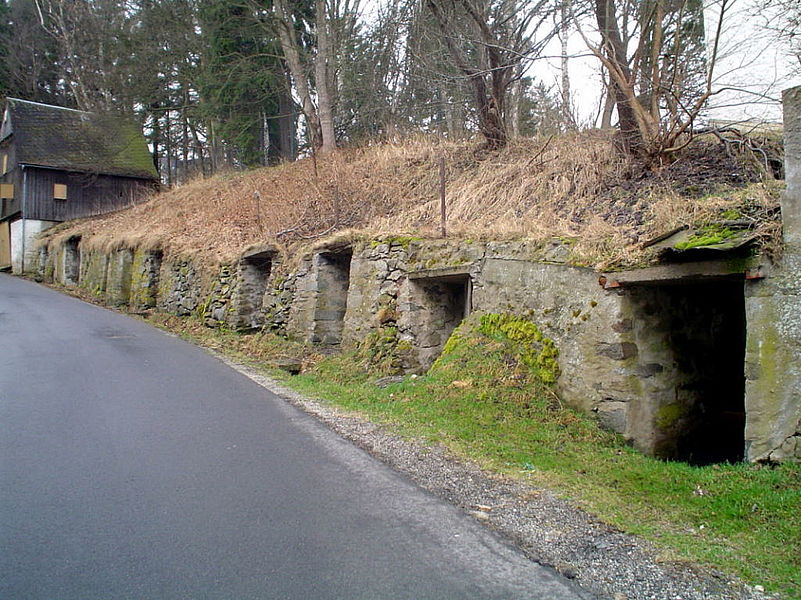
- Naturpark Fichtelgebirge
- Discover
- Hollow paths & Rock Cellars

Hollow paths & Rock Cellars in the Fichtelgebirge
Relics of former times are the hollow paths, called “Hohlweg”, in the Fichtelgebirge,
which had been cut into the relief by centuries of wagon use. If they were close to
settlements, such cuts into the landscape were often used to construct earth and rock
cellars. They were built to store potatoes, beets, beer and meat. The edges of the
hollow paths are usually covered with native, site-specific trees and bushes that form
hedges. These semi-natural structures form a connection between open landscape
and settlement. In this sense, they are to be seen as a kind of transitional structure
(e.g. “Birnbaumgasse” at the Wunsiedel “Katharinenberg”).
The kinds of trees and shrubs that can be found in the hollow paths of the
Fichtelgebirge:
• wild rose
• hazel
• hawthorn
• black elderberry
• Norway and sycamore maple
• common oak
• bird cherry
• silver birch
• aspen
• Wych elm
• rowan
• goat willow etc.
Hollow paths are a paradise of native hedge birds such as the dunnock, wren,
warblers etc. Older trees with their fissures offer summer quarters for bats.
The earth and rock cellars in the hollow paths are important ecological structural
elements of nature conservation and also a symbol of our building traditions and
stonemasonry. And as artificially created caves, they give evidence of the geological
conditions of the rocky landscape of the Fichtelgebirge. Rock cellars were important
for storing food, e.g. potatoes. They are often abandoned, partly derelict monuments
of our agricultural landscape. Cellars, that are hardly used any more, are known
habitats for animals (winter refuge for bats) and often described as small biotopes in
semi-natural environments all over Bavaria. The Kellerberg mountain near
Weißenstadt with roughly 130 cellars is of more than local significance in our area.
And in the 50 rock cellars in the Kellergasse at the edge of Wunsiedel, particularly
many kinds of wintering bats have been recorded with the FFH species barbastelle,
greater mouse-eared bat and Bechstein’s bat. The row of cellars at the Hohenbucher
Weg in Marktleuthen and the cellar in the Hohe Gasse Dörflas are under monument
protection.
The following cellars and hollow paths (Hohlweg) are listed as especially valuable:
• row of cellars in the Egerstraße Arzberg: pennywort in crevices
• landscape element hollow path „Hohlweg Teichmühle/ Seußen“
• cellar in the Gieselgasse Seußen
• hollow paths around Oschwitz near Arberg with individual cellars
• cellar in the northern slope of the Eger near the Hammermühle Hohenberg
a.d. Eger
• Kellergasse Hohenbuch Marktleuthen: winter refuge of the barbastelle and
northern bat
• Hohlweg in Großwendern: hollow path with woody plants and cellar hills
• landscape element hollow path south of Habnith/ Marktleuthen
• cellar Hohe Gasse Dörflas Marktredwitz: old narrow pass with cellars, winter
refuge for bats
• Kellergasse in Redwitzit Marktredwitzer Straße and Hauptstraße Brand/
Marktredwitz
• cellar in Röslau: vegetation in wall crevices and remnants of nutient-poor
grassland
• natural monument Mühlberg and Alte Heerstraße Schirnding with rows of
cellars
• hollow paths in Dietersgrün and Raithenbach (ND): hollow paths with woody
plants and cellars
• landscape element hollow path southwest of Spielberg with rock cellars
• landscape element Tannenreuth near Wunsiedel
• cellars in Weißenstadt: more than 200 cellars in the district of Weißenstadt,
occurrence of bats and luminous moss
• cellar combinations around Voitsumra/ Weißenstadt
• Birnbaumgasse, Katharinenberg and Kellergasse Wunsiedel: Orock cellar at
the Hangfuß, winter refuge for bats with interregional importance
• hollow path near Breitenbrunn, Wunsiedel: semi-natural woody plants and
cellars
• hollow path in Schönlind east of Wunsiedel: narrow pass with woody plants


